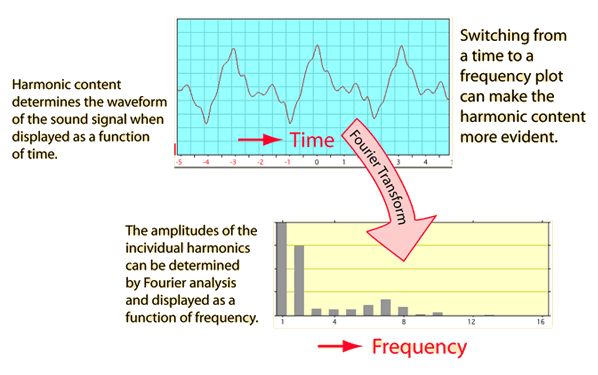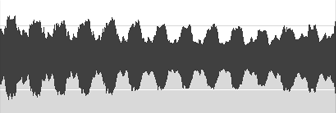Timbre
Sounds may be generally characterized by
pitch,
loudness, and quality. Sound "quality" or "timbre" describes those characteristics of sound which allow the ear to distinguish sounds which have the same pitch and loudness. Timbre is then a general term for the distinguishable characteristics of a tone. Timbre is mainly determined by the
harmonic content of a sound and the dynamic characteristics of the sound such as
vibrato and the
attack-decay envelope of the sound.
Some investigators report that it takes a duration of about 60 ms to recognize the timbre of a tone, and that any tone shorter than about 4 ms is perceived as an atonal click. It is suggested that it takes about a 4 dB change in mid or high harmonics to be perceived as a change in timbre, whereas about 10 dB of change in one of the lower harmonics is required.
Harmonic Content
The primary contributers to the quality or
timbre of the sound of a musical instrument are harmonic content,
attack and decay, and
vibrato. For sustained tones, the most important of these is the harmonic content, the number and relative intensity of the upper harmonics present in the sound.
Some musical sound sources have
overtones which are not
harmonics of the fundamental. While there is some efficiency in characterizing such sources in terms of their overtones, it is always possible to characterize a periodic waveform in terms of harmonics - such an analysis is called
Fourier analysis. It is common practice to characterize a sound waveform by the spectrum of harmonics necessary to reproduce the observed waveform.
The recognition of different
vowel sounds of the human voice is largely accomplished by analysis of the harmonic content by the
inner ear. Their distinctly different quality is attributed to
vocal formants, frequency ranges where the harmonics are enhanced.
Attack and Decay
The primary contributers to the quality or
timbre of the sound of a musical instrument are
harmonic content, attack and decay, and
vibrato.
The illustration above shows the attack and decay of a plucked guitar string. The plucking action gives it a sudden attack characterized by a rapid rise to its peak amplitude. The decay is long and gradual by comparison. The ear is sensitive to these attack and decay rates and may be able to use them to identify the instrument producing the sound.
This shows the sound envelope of striking a cymbal with a stick. The attack is almost instantaneous, but the decay envelope is very long. The time period shown is about half a second. The interval shown with the guitar string above is also about half a second, but since its frequency is much lower, you can resolve the individual periods in that sound envelope.
Vibrato/Tremolo
The primary contributers to the quality or
timbre of the sound of a musical instrument are
harmonic content,
attack and decay, and vibrato. The ordinary definition of vibrato is "periodic changes in the pitch of the tone", and the term tremolo is used to indicate periodic changes in the amplitude or loudness of the tone. So vibrato could be called FM (frequency modulation) and tremolo could be called AM (amplitude modulation) of the tone. Actually, in the
voice or the sound of a
musical instrument both are usually present to some extent.
Vibrato is considered to be a desirable characteristic of the human voice if it is not excessive. It can be used for expression and adds a richness to the voice. If the harmonic content of a sustained sound from a voice or wind instrument is reproduced precisely, the ear can readily detect the difference in timbre because of the absence of vibrato. More realistic synthesized tones will add some type of vibrato and/or tremolo to produce a more realistic tone.
Above is an amplitude plot of a sustained "ee" vowel sound produced by a female voice. The periodic amplitude change would be described as tremolo by the ordinary definition of it. You could also hear pitch variation along with it, so vibrato was present as well. That is commonly the case. The period of the amplitude modulation is about 0.17 seconds, or a modulation frequency of about 5.8 Hz superimposed on a tone of frequency centered at about 395 Hz. Rough frequency measurements gave frequencies of 392 Hz when the amplitude was high and 399 Hz when the amplitude was low. It is not known whether or not this kind of variation is typical. Scaling the amplitude variation gives a range of about 7 dB in intensity associated with the amplitude modulation.












